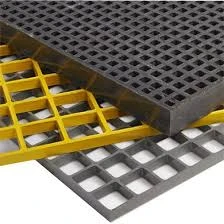loading...
- No. 9, Xingyuan South Street, Dongwaihuan Road, Zaoqiang County, Hengshui, Hebei, China
- admin@zjcomposites.com
- +86 15097380338
- Welcome to visit our website!
Specifications for GRP Grating and Its Applications in Various Industries
Understanding GRP Grating Specification
Glass Reinforced Plastic (GRP) grating is a popular choice in various industries due to its lightweight, durable, and corrosion-resistant properties. This type of grating is widely utilized in applications ranging from walkways and platforms to drainage covers and chemical processing facilities. Understanding the specifications of GRP grating is crucial for selecting the right type for a particular application. In this article, we will explore the key specifications and considerations that come into play when dealing with GRP grating.
Key Specifications of GRP Grating
1. Material Composition GRP grating is made from a composite material that typically includes fiberglass and resin. The fiberglass provides strength and stiffness, while the resin offers corrosion resistance and flexibility. The type of resin used can vary; common choices include epoxy, polyester, and vinyl ester, each providing different levels of performance based on the application.
2. Load Bearing Capacity One of the most critical specifications of GRP grating is its load-bearing capacity. This is usually measured in terms of uniform load and point load. The load capacity can vary based on the grating's thickness, bar spacing, and the type of resin used. It is essential to consult load tables provided by manufacturers to ensure that the selected grating can withstand the anticipated loads in your specific application.
3. Bar Spacing and Thickness GRP grating comes in various thicknesses and spacing options between the supporting bars. Bar thickness typically ranges from 25mm to 38mm, and spacing can vary based on intended use, typically between 30mm and 50mm. Software tools and guidelines can assist in determining the best combination of bar spacing and thickness based on expected foot traffic and loads.
4. Anti-Slip Properties Safety is paramount in environments where GRP grating is used. Most manufacturers provide grating with anti-slip surfaces to minimize the risk of slips and falls. This can be achieved through various surface treatments or the incorporation of textured patterns during manufacturing. When selecting grating for areas exposed to moisture or hazardous materials, ensure the anti-slip properties meet regulatory requirements.
grp grating specification

5. Corrosion Resistance One of the primary advantages of GRP gratings is their exceptional resistance to corrosion. This makes them ideal for use in chemical processing, marine environments, and wastewater treatment facilities. Depending on the resin type, GRP grating can withstand a wide range of chemicals, including acids, alkalis, and solvents. Always refer to chemical resistance charts provided by suppliers to ensure compatibility with specific substances.
6. Dimensional Stability and Flame Resistance GRP grating exhibits excellent dimensional stability, which means it can maintain its shape and performance characteristics over a wide range of temperatures and environmental conditions. In many applications, flame resistance is also a key consideration. Depending on the formulation, GRP gratings can be designed to meet specific fire safety standards, making them suitable for use in industrial settings.
7. Installation and Maintenance The ease of installation is another significant consideration. GRP grating is generally lightweight, making it easier to handle and install compared to metal alternatives. They can be cut to size using standard tools and usually come with interlocking designs to facilitate easy assembly. In terms of maintenance, GRP gratings are low-maintenance; they do not require painting and can be cleaned easily with water and mild detergents.
8. Environmental Impact and Sustainability As industries shift towards more sustainable practices, GRP grating provides an eco-friendly solution. They are often produced from recyclable materials, and their long lifespan can lead to a reduced environmental footprint over time. Additionally, their lightweight nature contributes to lower transportation costs and emissions when compared to traditional materials.
Conclusion
Understanding the specifications of GRP grating is essential for making informed decisions in material selection for construction and industrial applications. Factors such as load-bearing capacity, corrosion resistance, anti-slip properties, and ease of installation play pivotal roles in ensuring safety and functionality. As industries continue to prioritize sustainability, GRP grating represents an effective, long-lasting, and environmentally friendly solution for various applications. When choosing GRP grating, always refer to manufacturer specifications and guidelines to ensure optimal performance and safety.
-
The Rise of FRP Profiles: Strong, Lightweight, and Built to LastNewsJul.14,2025
-
SMC Panel Tanks: A Modern Water Storage Solution for All EnvironmentsNewsJul.14,2025
-
GRP Grating: A Modern Solution for Safe and Durable Access SystemsNewsJul.14,2025
-
Galvanized Steel Water Tanks: Durable, Reliable, and Ready for UseNewsJul.14,2025
-
FRP Mini Mesh Grating: The Safer, Smarter Flooring SolutionNewsJul.14,2025
-
Exploring FRP Vessels: Durable Solutions for Modern Fluid HandlingNewsJul.14,2025
-
GRP Structures: The Future of Lightweight, High-Performance EngineeringNewsJun.20,2025
